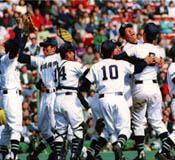OKINAWA FEVER:
Japan's Subtropic Island a Powerhouse of Excitement
June 1, 1999

Okinawa Shogaku High School celebrates their national
baseball championship. (Tokyo Chunichi Sports)
"Sorry to keep you waiting for so long. . . ." So begins the hit song
"Nagai Aida" (A Long Time), by popular Okinawan female duo Kiroro, which
was used as the opening theme of the seventy-first spring high school
baseball tournament held from late March through early April 1999. These
words foretold how the tournament would culminate--in the first victory
by an Okinawan high school since the island prefecture began to participate
in this twice-yearly event in the summer of 1958. Okinawa Shogaku High
School's team finally brought home the trophy that had been awaited
for 41 years.
Spring and Summer Koshien
Baseball, including high school baseball, is one of Japan's most popular
spectator sports. National high school tournaments are held every spring
and summer at Koshien Stadium in Nishinomiya, Hyogo Prefecture, where
teams from across the country vie for the national high school championship.
The two tournaments differ in character. While only those teams that
have won the qualifying rounds in each prefecture can compete in the
All-Japan High School Baseball Championship Tournament, commonly known
as the "summer Koshien," teams to participate in the National Invitational
Senior High School Baseball Tournament (the "spring Koshien") are selected
by the Japan High School Baseball Federation based on the results of
the fall regional tournaments and other competitions.
Pride of Okinawa
Until Okinawa was reverted from U.S. to Japanese administration in 1972,
Koshien athletes from the island had to carry passports when entering
mainland Japan. Because of the Plant Protection Law, they were not even
allowed to bring home the handfuls of soil they had taken from the stadium,
a traditional memento for those who play in the prestigious tournament.
The best they could do was to sprinkle the soil into the ocean on their
way back by ferry or at Naha Airport, near the prefectural capital.
Previously the highest standing for Okinawan schools was second place,
achieved twice at the summer Koshien. Watching 21 Okinawan schools play
in the spring Koshien and 31 in the summer tournament, Okinawa's 1.29
million residents dreamed of winning the national title.
Local newspapers gave extensive coverage on the long-awaited triumph.
At Naha Airport the young players were greeted by some 1,700 local citizens,
and 2,500 gathered at their school to hear the team report on their
victory. Even Prime Minister Keizo Obuchi expressed his congratulations,
saying, "This is big news, and I'm sure the Okinawan people are delighted."
Trendy Okinawa Looks Ahead
Heat waves from Okinawa have actually been sweeping across Japan for
a couple of years now. In addition to the above-mentioned duo Kiroro,
many popular singers from the prefecture have won national fame, including
Namie Amuro and the groups Max and Speed. Previously the public impression
of Okinawa had been tinted strongly with images of war and U.S. military
bases. But now Okinawa has transformed itself into a land full of vitality,
always on the cutting edge. It is no exaggeration to say that Japan's
popular culture and trends nowadays often originate in Okinawa. Now
that it has been chosen as the site of the Group of Eight summit meeting
in 2000, Okinawa Prefecture is attracting even more attention. In the
song "Mirai-e" (Into the Future), Kiroro sings, "Come, look ahead of
you; this is your future"--lyrics that seem to describe Okinawa as it
gets ready to spread its wings and fly out into the world. The Okinawa
summit can be expected to send some passionate messages to the world,
too.
 Edited
by Japan Echo Inc. based on domestic Japanese news sources. Articles presented
here are offered for reference purposes and do not necessarily represent
the policy or views of the Japanese Government.
|



















